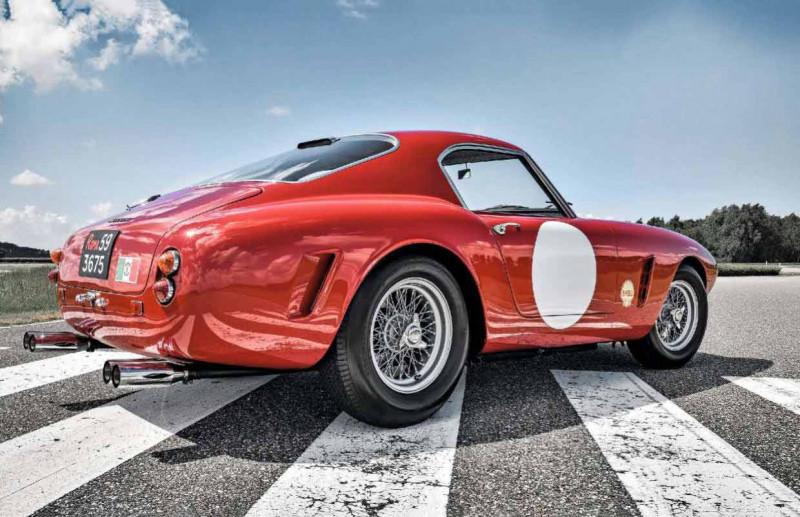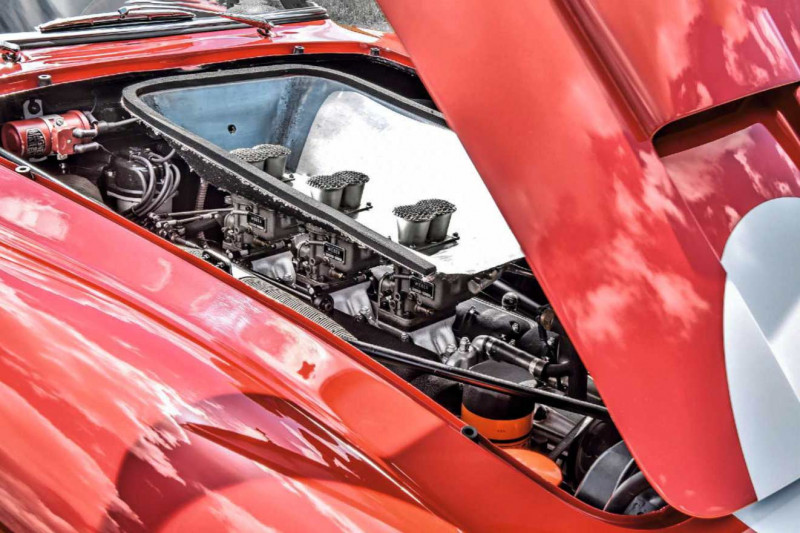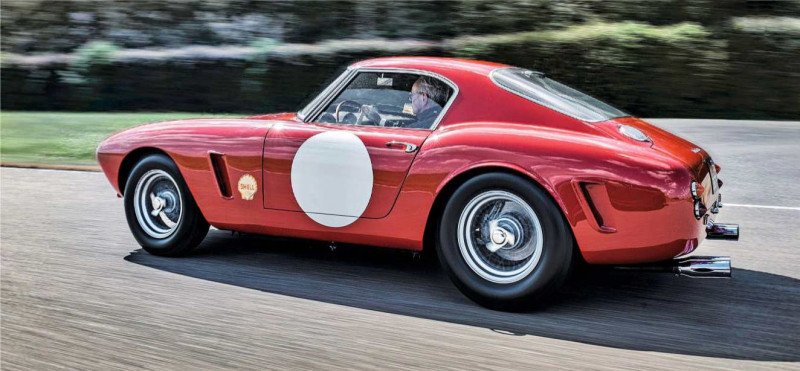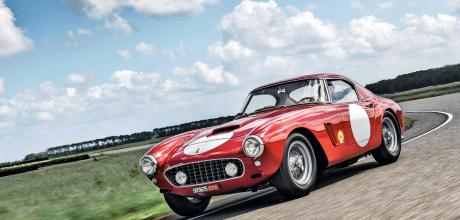1960 Ferrari 250GT SWB Competizione
The Ferrari 250GT SWB Competizione was born to do battle. That fact that this one barely did makes it special in its own way. We find out how. Words Ton Roks. Photography Lilla Leopold.
Never raced but raring to go – the roadgoing Competizione
The Racer That Didn’t On track in a unique Ferrari 250GT SWB Competizione
It is without a doubt the best sports car Ferrari has ever made – arguably the best sports car from any manufacturer. You could actually take it to a track, win races and then drive home.’ These words are not mine but those of Stirling Moss, who had a large share of the many victories that are credited to the Ferrari 250GT SWB (short-wheelbase) Berlinetta.

That text by Moss, who extensively praises the SWB in his book My Cars, My Career, has reinforced my opinion that this is one of the most desirable automobiles ever. That feeling has been around for a long time, fueled by all the times I’ve seen a SWB racing – with open exhausts during the Coppa d’Italia, and in full four-wheel drifts at Spa and Goodwood, V12 howling down the straight. That long bonnet, the flanks with those well-defined muscles, the exquisitely balanced proportions, the way it combines the fighting spirit of a racer with the style of a Gran Turismo – it’s just exquisite. In fact, I prefer the elegantly understated SWB to the GTO, whose lines can seem over-exaggerated.
‘As the needle climbs, the note gets warmer and more homogeneous’
And now, at the police practice circuit in Lelystad, just outside Amsterdam, I finally have the opportunity to drive a SWB – and it’s one of the best. Chassis number 1849GT is a super-original early Competizione from 1960. It is unclear exactly how many SWBs Ferrari built, but authorities peg it at 162, of which 73 were Competizione variants for hardened customers who planned to drive significantly more on circuits than on public roads. The lighter Competizione features a more powerful engine and an all-aluminum body, designed by Pininfarina and fashioned by Scaglietti. The standard SWB, the Lusso, has to make do with a steel body, albeit with aluminum doors, bonnet and bootlid.

Although the SWBs all look similar superficially, there are quite a few differences between the cars – some have bumpers, some not, the cooling holes for the brakes at the bottom of the nose can differ in shape, and there are quite a few other detail differences. This car is an early SWB, meaning it has a slightly different grille to later models, and the side windows are differently shaped in the top rear corners. The rear also differs, with a cooling opening in the Perspex window – in later versions it is in the roof.
The cockpit is surprisingly spacious, but there is no room behind you for luggage, not even in the boot, which is largely occupied by the spare wheel, a 120-litre fuel tank with its thick filler tube, and a large, beautifully shiny quick-jack. You sit on bucket seats, which are covered with black leatherette. ‘Some owners opt for leather when doing a restoration, but it shouldn’t be that way – all Competiziones were supplied with artificial leather,’ says its owner, Dutch collector Henk Koel.

The upper void of the large wood-rimmed wheel offers up two large, individually nacelled ‘soup bowl’ Veglia dials. The left is a tacho that indicates up to 8000rpm without a redline in sight; the right is a speedometer showing 300kmph (186mph). Five smaller dials in the centre of the dash show water and oil temperatures, oil pressure, the status of the petrol tank and the passage of time.
Henk has already brought all fluids up to temperature and warmed the Dunlop Racing tyres, size 6.00in at the front and 6.50 at the rear. The Ferrari is on 16-inch Borranis, as it should be. For road journies where Dunlops are not allowed, Henk prefers 15-inch wheels with 215/70/15 Michelin XWXs.
You have to turn and press the ignition key to start the V12, then with a pump of the throttle the three double Webers immediately do their work, the mixture ignites and the twelve cylinders come to life in rapid succession. All SWBs have a highly oversquare V12. The steel Lussos employ the Type 168 variant with a compression of 9.2:1 and three Weber 36DCLs, delivering 240bhp and 193lb ft of torque. The aluminum Competiziones were bestowed with with a higher-compression version, designated 168B, which also had larger carburettors and often inhaled through a cold air chamber connected to the bonnet vent. The 168B made more torque and supposedly increased power to 280bhp, although Ken Gross claimed it was more like 275bhp in his book Ferrari 250GT SWB: The Definitive Ferrari Road-race Car.

Ferrari also made some extreme versions of the 168B, with an oil sump, camshaft covers and timing case cast in magnesium. These engines, called 168 Comp/61, also had special lightweight pistons, stronger connecting rods (because of the higher compression of 9.7:1) and more aggressive camshafts, developing in the region of 290bhp. SWBs with these engines, so-called SEFACs (standing for Società Esercizio Fabbriche Automobili e Corse, Ferrari’s official company name after the restructuring in 1960) also had a lighter chassis, were stripped of any concessions to refinement, and had an almost paper-thin aluminum body. Their V12s provide a brutal blast of power at 5500rpm; below that they are rather cranky and hard to drive on the road. The SEFAC ‘hot-rods’ are seen by some as the ultimate SWBs, but you can argue otherwise – they are pure racers, and as a manifestation of the road-racer phenomenon, a Competizione is far more accomplished.
That’s not to say the Competizione’s V12 is in denial about its combative nature. It responds instantly to the accelerator, and offers one of the most melodic sounds in the business. It’s a complex machine and the metallic cacophony of the 24 valves and twin camshafts give its exhaust note an aggressive edge, but as soon as the needle climbs it gets warmer and more homogeneous. The clutch is neither easy nor excessively heavy, and the lever clicks into gear sweetly. The gearshift gate that we later came to find so typical of Ferraris had not yet arrived, so the lever just protrudes out of a leather sleeve into the cabin. It’s perfectly placed – if you drop your hand off the steering wheel, you have it. I shift just above 3000rpm; the action is smooth and fluid, the movements tightly defined and mechanically satisfying. It’s a delight to finally drive such a long-coveted Ferrari, look over the dash and that long bonnet and feel the greedy push of the V12. The steering wheel feels great in my hands. It’s large, requires little force, and the Ferrari listens through it as intently as a therapist. The SWB amazes me by its agility and by the way in which it communicates. You can feel exactly what is happening beneath you through your backside, spine and hands; every bump is passed on. If you steer the Competizione a little harder through the corners, so that more weight rests on the outer front wheel, you can even feel the profile of the Dunlop Racings.

The chassis of the SWB is surprisingly simple, especially at the rear with that rigid rear axle, which is kept in line only by leaf springs, with friendly help from two longitudinal arms. In a car with such power there’s a risk that the rear axle will move slightly during acceleration or heavy engine braking, creating an undesirable steering effect. However, this is not noticeable with the Competizione. It’s keen and confident in the bends, and won’t be unbalanced by unexpected corrections with the steering wheel or accelerator pedal. The balance is exquisite – there is no pronounced tendency to understeer or oversteer, it feels nice and neutral, and you can understand why you have seen it so often – on relatively narrow Dunlop Racings – being danced in beautiful four-wheel drifts. Not only does this seem to be the fastest method, it also feels that the Ferrari is most in its element here, and has even been tuned to do so by the factory.
There is nothing to criticise about the brakes. Ferrari was late with the switch to disc brakes but fortunately the SWB is equipped with them, Dunlop being the manufacturer. They slow the car neat and straight, but if you want to shed a lot of speed you have to shoe them firmly. The four-speed gearbox is synchromeshed, but when downshifting I double declutch to be as mechanically sympathetic as I can. Incidentally, this short throttle blip mid-shift sounds great and it’s so easy to do – the accelerator is positioned so well that you can grab it with the edge of your right heel while the ball of your foot handles the braking.
Happily, the straight section of the police practice circuit is long enough to let the V12 sing a little. In a lower rev range it’s smooth and sweet, but as soon as you get above 4000rpm, it’s as if the V12 notices its cage has been opened, and the beast within roars into attack mode. It sounds more and more awesome the closer it gets to the imaginary redline at around 7500; you feel the SWB’s nose pull up slightly, and you’re pushed firmly into the back your pseudo-leather perch. The Competiziones were good for a top speed of 125-155mph, depending on the final drive fitted and whether your desire was to win a hill climb with stripe-drawing acceleration, or barrel along the Mulsanne. The longer I drive it, the more the SWB confirms what a fantastic machine it is – and such a satisfying one too. There’s nothing that disappoints or detracts from the myth. Brakes, handling, balance, steering, that V12 singing so gloriously everywhere – it’s all so harmonious.
The SWB was developed by the dream-team of Carlo Chiti, Giotto Bizzarrini and Mauro Forghieri. They had motor sport in mind, and duly shortened the wheelbase by 20 centimeters compared to its predecessor – the 250GT – which made it even more agile on the track without much sacrifice in its capabilities as a GT. After all, the SWB was born in a time when the best gran turismos had a dual character. You drove to the track, put numbers on the doors and tape over the headlights, and went racing. Afterwards, you collected the trophy, installed the luggage and your girlfriend in the car, and drove home. Better days, some might say.
Chassis 1849GT spent the first five years of its existence in Italy, hence the Roman registration. Its period competition record remained blank, except for a single hill climb, making it one of the few SWBs to get through its life without accident damage. Which is not to say that it has remained intact in all respects. It moved to the USA in 1968 and was acquired in 1972 by one John Andrews.
He was a collector who never threw anything away, loved fast cars and had a habit of tearing from Moreno Valley to Los Angeles before dawn to avoid rush hour. Over the years he developed into a somewhat eccentric figure, according to a discussion about Andrews and his many cars in one Ferrari forum. In any case, he compromised the originality of the Competizione by having the beautiful dashboard painted in psychedelic colours. At one point he stored the car in parts in one of his many garages.
American Ferrari specialist Michael Sheehan eventually bought the SWB – happily Andrews had retained all parts, storing them in boxes next to and inside the car, which was otherwise still completely damage-free bar a small dent in the rear panel. Sheehan brought the Ferrari back to top condition on behalf of the new owner Reza Rashidian, the son of the Shah of Persia.
In 1999 it was acquired by Henk, who had a SWB on his wishlist for a long time, ‘When I sold part of my business, I finally had the opportunity to fulfill my heart’s desire. The Ferrari was then at DK Engineering, which was selling it on behalf of Reza Rashidian. I went there to have a look together with my brother Nico. We had been told in advance that the seller thought it important to whom the car was sold; it had to be an enthusiast. Nico and I did not meet the selling owner ourselves, but when we looked at the car, someone was watching us from the balustrade the whole time. That turned out to have been Reza.’
To go into all the racing successes of the SWB model is more the remit of a book than this feature; the list is simply too long. But there a few triumphs that should not be left unmentioned, such as the excellent performances at Le Mans.
In 1960 the SWBs blitzed the GT3.0 class – unsurprising because they had it almost to themselves – and placed fourth to seventh overall, the higest finisher being the car of Fernand Tavano and Pierre Dumay. In 1961, the year before they passed the baton to the 250GTO, the SWBs won their class again, with the private entry of Pierre Noblet and Jean Guichet finishing third overall.
It could have been even more beautiful back then in 1961, Stirling Moss reveals in his book. He drove with Graham Hill in the darkblue Competizione now owned by Ross Brawn. ‘We averaged 190kmph in the first hour and a half, screaming down the Mulsanne Straight at 7700rpm. The car felt great. After 21 laps my best time was four minutes and eight seconds, and in the evening we were in third position overall and miles ahead of the GT category.’ At one point, the Competizione even got ahead of Mairesse and Parkes’ Ferrari 250TR prototype, which would eventually finish second.
However, a foolish error would see Moss and Hill drop out: the team had failed to disengage the cooling fan – unnecessary for Le Mans – and the persistently high revs caused a blade to break off and shear through a water hose, with disastrous consequences for the V12.
SWBs also triumphed three times in the Tour de France Auto which, with its combination of hill climbs, circuit racing and long road sections, was the most versatile event on the calendar at the time. In 1960 the three first places were taken by Short Wheelbases and in 1961, even the first four positions. A SWB also triumphed in the Tour de France in 1962, with three GTOs finishing behind it.
The SWB has convincingly proven itself time and time again. Today, 1849GT has continued that theme.
TECHNICAL DATA 1960 Ferrari 250GT SWB Competizione
- Engine 60deg 186B V12, dohc, three Weber 40DCL6 carburettors
- Max Power 280bhp @ 8000rpm
- Max Torque 202lb ft @ 5500rpm
- Transmission Four-speed manual, rear-wheel drive
- Suspension
- Front: double wishbones, coil springs and telescopic dampers, antiroll bar.
- Rear: live axle with leaf springs and longitudinal arms, telescopic dampers Brakes Discs all around
- Weight 960kg (dry)
- Performance 0-60mph: 6.3sec;
- Top speed: 125-155mph, depending on rear axle ratio
- Fuel consumption 12mpg
- Cost new £3158
- Classic Cars Price Guide £7.5m-£10m
Ferrari’s greatest GT racer? The floor is open for debate on that – but the SWB’s track record is indelible.
Vents cool the disc brakes, which Ferrari had recently embraced No Kamm-tail to be found here – some might say for the better… Quick access to the 120-litre fuel tank that writes off any luggage space.
‘It’s a delight to look over the dash and that long bonnet, and feel the greedy push of the V12’
Aluminium box rams cold air into the three Weber carburettors Protruding quad exhausts are crucial to the power, and elegant stance.
Bonnet vent feeds the carburettors with all the cold air they could want SWB details can vary from car to car, such as the grille and vent styles If fewer were made, would the SWB unseat the GTO as the most valuable Ferrari GT racer?
Chassis 1849GT had been partly dismantled by a previous owner… ...whose eccentricity was revealed in this psychedelic dashboard paint.



Exhaustive detail
The Ferrari 250SWB’s extended exhaust tailpipe trims (The Racer That Didn’t) were branded SNAP (Scarico Negativo Aria Pressione or Exhaust Negative Air Pressure) and were fitted to Ferraris in 1959 and 1960. They were sold in the UK with the sales slogan, ‘Ferrari Fit SNAP and So Should You.’ The concept was one of reducing back pressure in the exhaust system. Concentric tubes included a lozenge-shaped slit in the outer tube wall where air could enter at high speed, causing a vortex at the tip of the exhaust pipe and supposedly sucking engine gases out. I bought one and fitted it to my Mini – but although it looked great, I don’t remember any advantage whatsoever in either performance or fuel consumption. They are still sold at £1500 each (you need four for the restoration), but I guess that this is small beer if you own a 250SWB.
Swapping 250 SWB ownership
Just a small correction on the 250SWB Ferrari article written by Ton Roks. He mentions the dark blue car of Moss and Hill at Le Mans now owned by Ross Brawn, when in fact that car is owned by Clive Beecham, the 1961 Rob Walker car. Brawn’s car is the 1960 version.